None of us can do our jobs the same way we did a few months ago. However, we can use technology and tools to try to make our remote admissions processes more accessible and approachable during this strange time.
It’s going to be challenging, but there are enough great tech solutions to ensure we can engage, enroll, and accept students for next school year.
Here are a few recommendations for tools that can help your team attract, engage, and assess applicants for next year in a remote working environment.
Remote campus tours
Google Maps for College Visits
Google has done a great job of “mapping” most colleges. You can create a guided tour for students using Google My Maps and highlight all of the buildings, best study spots, and more.
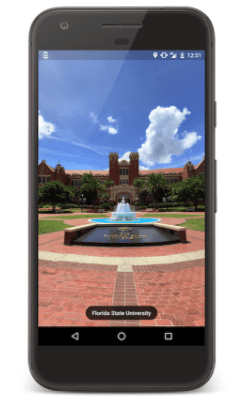
Florida State University via Google Maps
EAB Virtual Tours (Formerly YouVisit)
Virtual Tours lets prospective students explore your campus from anywhere on any device. If you don’t already have the footage, unfortunately, this one may be difficult to set up.
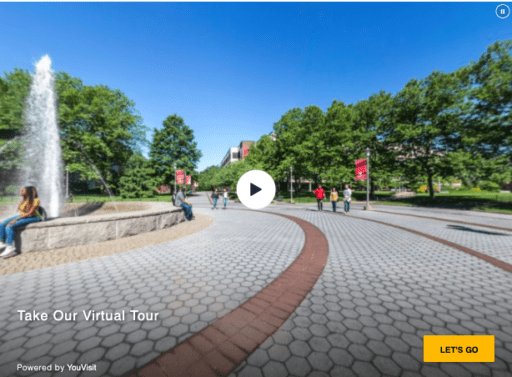
Screenshot of an EAB YouVisit virtual tour
Virtual tours and search tools for aspiring Masters of Business programs. Experiences include campus tours, meet students, and hear from faculty and staff. MBA and Masters of Business programs only.
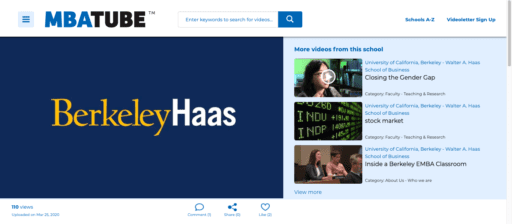
An MBATube video page
Remote open house
vFairs allows you to offer virtual open houses where students can explore your programs.
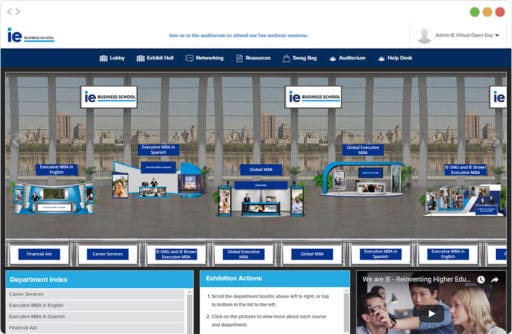
IE Business School Fair in vFairs
CollegeWeekLive, on the other hand, is more student-facing. For colleges, they’ll curate live information presentations but also serves as portal for students to chat live with admissions teams as part of PlatformQ’s offerings.
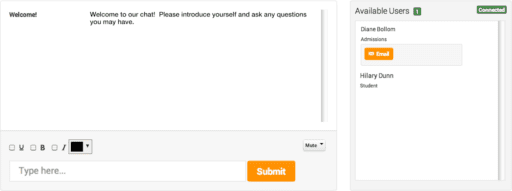
Chatting on CollegeWeekLive
Remote information sessions
Traditional: Zoom or GoToMeeting
You’re likely already offering remote information sessions or webinars. Video conferencing apps like Zoom or GoToMeeting allow multiple users to RSVP, attend and ask questions, and give you information about who showed up.

Social: Facebook or Instagram Live
Something new to try could be offering your information session on a Facebook or Instagram Live chat. Students can tune in directly from their feed to learn more about your program, hear from an alumni, and they are able to easily comment to send you a question.
See two examples below:
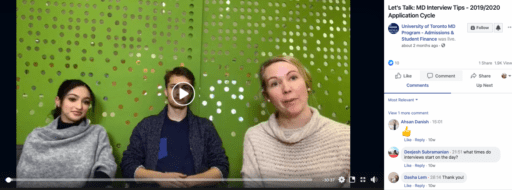
Here's an example from the University of Toronto's MD Program.

Here's another example from Western University
Interactive: Nearpod or Peardeck
Both Nearpod and Peardeck are designed for engaging K-12 classrooms, but they create a number of ways to make your slide decks way more fun! Add polls, activities, and short-answer questions with ease to make sure your audience members don’t doze off.
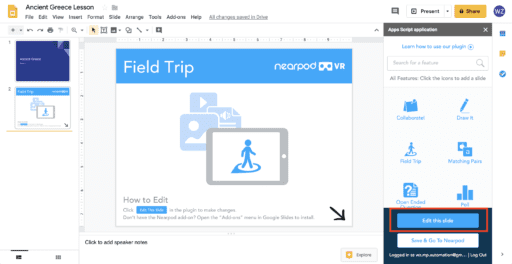
A sample of Nearpod enhancing slides
Remote admissions assessment
Replace in-person interviews and inconvenient video calls with an on-demand series of timed video and written questions. Kira Talent enables applicants to respond to timed video and written questions of your choosing from the safety of their home.
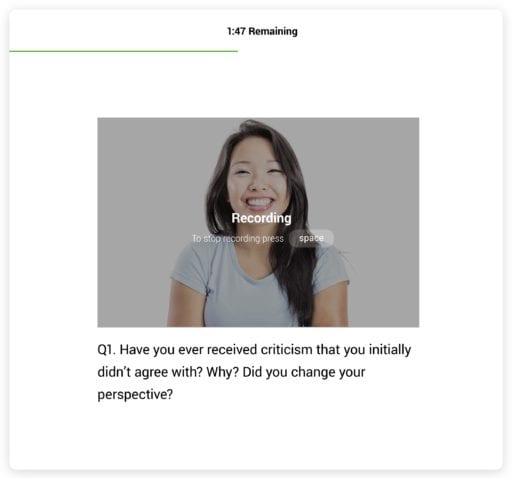
A Kira Talent video assessment
Application support for remote admissions
AdmitHub can take your web and FAQ content and transform it into an applicant-facing chatbot to help students find what they’re looking for. During COVID-19, they’re offering free access with pre-built campaigns featuring information from the CDC, WHO and more.
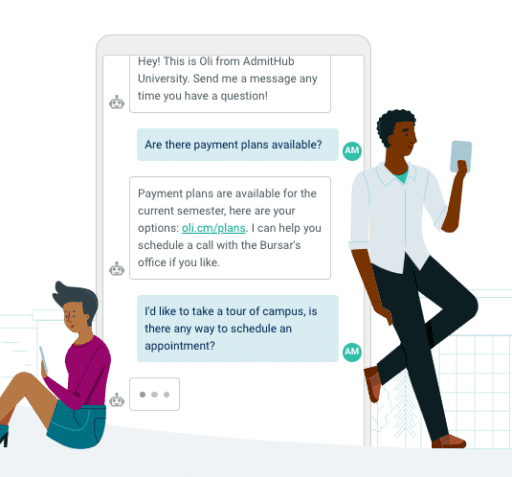
A preview of AdmitHub's Chatbot via admithub.com
Remote Career Services
VMock can help career service teams remotely serve students looking for career coaching as well as CV and Linked-in content advice using AI-based suggestion tools.
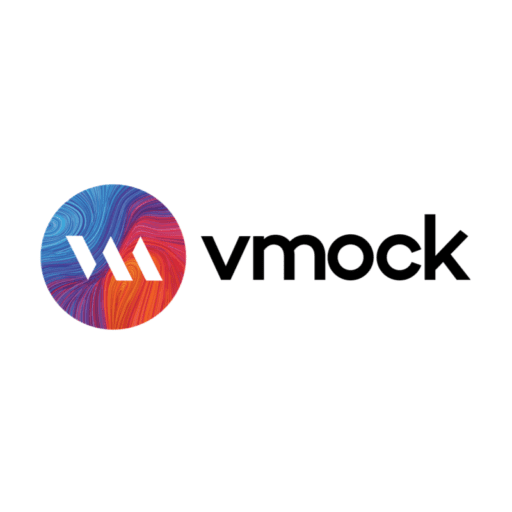

Saïd Business School’s Chief Information Officer Mark Bramwell may have one of the most interesting, and challenging, jobs in higher education. He leads the technology and systems arm of a business school embedded within an 800-year-old institution, the University of Oxford.
Bramwell’s team is tasked with delivering information and technology solutions that are on the same level as corporate multinational organizations while preserving the quality and reputation of Oxford.
Who better to ask about inspiring change and implementing new technology solutions in higher education?
We sat down with Bramwell to hear how his team gets buy-in for change internally, how the school approaches online education, and how they select and prioritize their education technology ("EdTech") projects and vendors.
For the CIOs, Directors of IT, or any other technology decision-makers reading, we hope you find this conversation as enlightening as we did!
Ask the CIO: Mark Bramwell, Saïd School of Business
Molly McCracken: Thanks for joining us, Mark. You're working within one of the world’s oldest universities. How do you inspire your colleagues, your departments, and your faculty members to make new changes and to be leaders in innovation when there's so much history within the institution?
Mark Bramwell: I was presenting on this yesterday at a Microsoft in Education event, so it's very current and very relevant.
We are a 21-year-old business school, embedded within an 800-year-old university. We are very proud to be embedded within that — to be part of Oxford and have a slightly larger degree of autonomy to be agile, to experiment, and to innovate within the business school as a ‘test bed’ for the wider University.
That becomes more paramount because, in essence, we are what you might call the closest to a commercial arm of the University. Our students, although I prefer to call them customers rather than students, are very different.
They are post-graduate (MBA, EMBA, MMPM, MFE, Diploma) and Executive Education coming from leading global organizations.
I would say their expectations are significantly different and higher than other students' at the university. With this, their expectations around technology are higher. They sometimes look at institutions, such as the business school, in terms of what they invest in technology and innovation — and consider that in their decision-making process as to where to attend.
So we continue to be an innovative organization that embraces technology, our focus being to provide our students and clients with a much richer learning experience when they come here: Whether that be face-to-face, blended, or entirely online, we think it's important to embrace technological development. And the reality is, if we don't, if we stand still, we'll fall behind. I don't think it's a question of inspiring colleagues, it's a question of can we afford not to?
"I don't think it's a question of inspiring colleagues, it's a question of can we afford not to?"
MM: With that in mind, the School has invested a lot in online education. I know there's kind of this stigma around the quality of a digital MBA and the quality of online education in general. Do you see your institution being able to change that?
MB: We do not, as part of our five-year plan at the moment, have an aspiration to provide an entirely online MBA. That's not part of our strategy. We do, however, have an online portfolio and that continues to increase.
In October 2017, we launched our first entirely online programs in Fintech, Blockchain, and Algorithmic Trading. We've just launched Digital Marketing, with further programs in AI and Women in Transformational Leadership planned. These are much more focused and concentrated modules of learning (e.g. 10-week, 10-module programs). To date, via these programs, we have built a very vibrant and active online community of over 8,500 course participants.
However, we do experiment and additionally augment content online in both a blended and flipped scenario.
We do this by providing reading lists and content in advance of the classes. For example, if we're running a program on Digital Marketing we might provide some concept as to the key terms, themes, and pillars around Digital Marketing so we're not spending value-adding time in the classroom explaining basic principles and getting the cohort up to a similar level of understanding. They all come with a predefined and base level of knowledge. Therefore, you get a much more interactive, discussion-based, and value-adding experience in the class.
That's where we're different, with the Oxford quality benchmark still very relevant. Whether it's an MBA, online program or module, the content and the experience has to meet a quality benchmark. That's a challenge that we constantly face in terms of “how do we translate what we might call the Oxford experience into an online program and best showcase our incredible faculty?”
The way we try to address this is with the quality of the content, delivery, and support that goes around the online program.
We provide augmented Q&A, online digital coaching, and online digital mentoring in support of a program so it's not just, “here's some online content, go and learn yourself.” Each program provides assisted learning, coaching, and mentoring to support, enhance and back this up.
MM: You don't have a vision for an online MBA in the next five years. Is that something you foresee changing? In the next 10 to 20 years, do you think the online MBA is going to be something that can be delivered at the same level?
MB: The world of learning is changing phenomenally fast. I don't think we can ever say never, especially since one of the biggest challenges we face at the business school is one of physical space. We're in a position at the moment where we can't accommodate any more physical students on campus. Therefore, one of the only ways we can expand our audience and reach is by growing our digital portfolio.
Although this is just personal thinking — and not currently Saïd Business School thinking or part of its strategic plan — opportunities may exist to partner and collaborate with other world-leading business schools. Perhaps the concept of a combined MBA with somebody like Harvard, Wharton, or Yale, where a student might do four months at Harvard, four months at Oxford, and four months online. It could be offered as the World's Best MBA, provided by the best business schools in the world, with the best faculty, professors, and content.
I think that could be amazing. There would be many barriers, sensitivities, and delivery changes to get through to make it a possibility ... but it's not impossible!
MM: When you're thinking about how to decide where to go, how do you ensure you're taking calculated risks when you try new technology? As in, what would you advise to other folks in a similar innovation position or information technology position? How do you figure out if you're making the right choices with your reputation at stake?
MB: Again, I think it's about balance and it's about taking calculated and considered risks all the time.
It's about measuring risk, impact, and the potential possibility of that risk occurring. That's what our jobs are. This extends to every new solution, new technology, and new partner that we bring into our portfolio. But that's also what is exciting about working in technology.
Sometimes though, it's just about trying things and experimenting with them. The best kernels of innovation sometimes come by trying something and seeing what happens.
"The best kernels of innovation sometimes come by trying something and seeing what happens."
And that's the benefit of providing empowered cultures where people feel comfortable to experiment and fail. It's very cliché, it's not new to us, but the cliché around “deliver quickly, fail quickly, and move on” is really important.
We go in to those experiments and innovations knowing that they're set up to be scalable and supportable, so we can scale them up very quickly if they're successful.
Going back a little bit to your first question around how we inspire people and how we motivate them: I feel empowered and enabled to be agile, to experiment, to innovate, and try things in a safe environment.
Don't get me wrong, there's considered risk, there's recklessness, and there’s using the right approach for the right solution and technology. For example, we probably wouldn't upgrade our finance system in an agile way. We would take a much more considered approach because of the potential impact of getting it wrong.
However, for our website we've been using more agile and sprint based methodologies to deliver quickly.
So it's all about finding the right balance. That's how we try to motivate and engage people as there's nothing more exciting than trying new things, seeing whether they stand or fail, and improving a student, faculty or staff members experience by facilitating positive change.
"That's how we try and motivate and engage people as there's nothing more exciting than trying new things."
MM: What would you tell other CIOs who maybe have the same approach and mindset you do, but are struggling with conservatism at their institution?
MB: Have the courage of your conviction. It's down to the individual. If somebody says no to you, it's very easy to give up.
Have the tenacity, the resilience, and the robustness to believe in what you're trying to do.
When I joined the business school and University, various people told me that I couldn't do things simply because they had never been done before. I love that challenge. For example, three years ago we were told that we wouldn't be able to outsource our infrastructure to the cloud. We were told we couldn't implement Canvas in a month and migrate all of our programs for the start of our new academic year to enhance our student experience, but we did it. We now have no physical infrastructure on site.
So you've just got to have the courage of conviction.
"You've just got to have the courage of your conviction."
A little bit of that comes from experience, in terms of knowing and believing what's right. A huge amount also comes from having the confidence in your team and your partners to deliver. Part of that comes from setting some clear direction and leadership around where you're trying to get to and what success looks like.
If you can build an empowered team where everybody knows where they are going, how they will contribute, and what success looks like, then everybody is motivated because they know what their role is. Then anything becomes possible.
MM: That's a really great perspective. Some of what I've heard from other schools is people feel like education technology solutions are coming in just for the sake of putting technology in — “Oh, we don't have a tech that does this, so we'll throw it in,” and then they don't end up keeping the solution because they don't have that greater vision and strategic idea of what purpose that tech serves.
MB: We have something called the IT Development Agenda which is our itemized list of projects. This is where our relationship with Kira Talent came in. But what I'll say is, it's not the IT Development Agenda, it's the business development agenda. IT is there to support, facilitate, and enable the delivery of business projects that involve technology. The projects are all business-sponsored, they are all business-driven, and there's a business requirement and business case for them. No project makes the IT Development Agenda without an accountable business sponsor.
We don't just introduce technology for technology’s sake, because the worst thing is to have something that doesn’t meet a business need, becomes redundant and/or is not used. Resources are precious (people, time, and money) so there's always a total cost of ownership to consider.
"We just don't input and introduce technology for technology’s sake, because the worst thing is to have something that doesn’t meet a business need, becomes redundant and/or is not used.
MM: So in the case of an admissions solution, the admissions department vocalizes their interest and leaves it with you to facilitate and deliver the end solution?
MB: Yes. I think what helps us and builds our credibility, is that over the past two to three years, we've built a degree of trust within the organization of being a team that delivers. So our business customers and partners have a lot more confidence in us in terms of saying, “We're clear, this is our objective – can you go and make it happen?”
However, all of the things like requirements, configurations, and testing are still heavily reliant on our business partners to confirm and sign off that a solution is what they want, is what was expected, and works as required.
Because at the end of the day, it's a business partnership. Whether or not a project is successful reflects on all of us. We're making an investment in technology and we're making an investment in this partnership. If it doesn't work, the executive sponsor for the project and myself as CIO would ultimately be accountable. So it's got to work and it's in both of our interests to make sure it does.
MM: As the “trusted source” within the school to validate partners, I’m curious how you go about evaluating a potential education technology vendor?
MB: Well there are a number of factors and considerations.
First is setting partnerships up from the beginning for success. When we enter into a new relationship, we typically don't see that as a six-month or a one-year agreement. You can't be a partnership for one year. For example, almost as soon as you sign you’re starting to think about renewing (or exiting).
So, if we're in it and have conducted appropriate due diligence, we like to commit long term because that allows both sides to invest time in each other and start building valuable partnerships. That comes with investing time so that we understand the partner and they understand us.
Then there are other practical things that we look for. We obviously consider things like financial viability, the stability of an organization, and security. You [Kira Talent] will know that having gone through our third-party security assessment. Compliance is increasingly important, particularly in the UK with new legislation such as GDPR and the strict security standards around that.
The other thing relates to people; I put a lot of stake in terms of people. Are they people that we're going to enjoy working with? Are they people who've got the interest of the business school and the university at heart?
What I'd say is, I don't like partners who have a chequebook mentality. We reach out about a problem and they say, “well that's going to cost you.” But part of that is also recognizing that a partnership doesn't start by driving people down to cost neutral. We realize that you have to make a margin, you have to make a profit, and we want you to because we want you to be there next week, next month, and next year.
So with that, we have certain service expectations. Because of our reputation and our standing, the solutions we bring into our system portfolio have got to work.
If we think about our Executive Education, we're developing some of the world’s top executives. Our MBAs are paying £80,000 a year to be with us. As we alluded to, they're not students, they're VIP customers. The technology has got to work.
And we want to provide that because if we want to be a world-class business school, we've got to have world-class technology with world-class partners.
"If we want to be a world-class business school, we've got to have world-class technology with world-class partners."
MM: To wrap up, we talked earlier about what isn’t in your five-year plan … but let’s talk about what you are most concerned about over the next five years at the Saïd Business School of Business.
MB: If I talk generally, the big trends are going to be around digital innovation, digital transformation, and digital agility.
Higher education is not immune to the fact that we're going to have to do more with less, and faster. Whether that be less money, less budget, or fewer people. And we're going to want to start to see the realization and delivery of benefits earlier.
I think long gone are legacy ERP-type projects where a project team goes and locks itself in a room for two years and you cross your fingers and hope that something comes out at the end (and that the business has not moved on or changed in those two years).
Businesses are changing every month. Not every year.
For example, our MBA is a one year program so our students are typically with us for one year.
We feel we are just getting to know them and then they graduate (to become valued alumni of the school). Then our next cohort comes in with potentially a totally different set of expectations, needs, and experiences.
We have to be agile in responding to that. With that, our IT teams have to be more generalist rather than specialist. They have to be jack-of-all-trades. They have to be customer-facing. They have to be supplier relationship managers, commercial contract managers, and project managers. They need all of those skill sets while also be able understanding how technology is changing and how it can be applied.
Above all, they have to be maitre d’s not waiters in making every customer (student, faculty, staff, guest) feel special and valued.
MM: That’s all the time we have today, but given what you shared above I can imagine how relevant and timely this conversation will be for your peers around the world in similar roles. This has been an absolute delight, thank you, Mark.
MB: Thank you, Molly.
The admissions process is an elaborate measurement of a person’s life.
Applicants input data, it is analyzed, considered, and eventually, a decision is made.
As students are considering their potential, their passions, and their education, a seemingly limitless horizon is ahead of them. However, the admissions process can often take their dreams and goals and make them feel like a series of checkboxes.
At the 2019 Center for Enrollment Research, Policy, and Practice’s (CERPP) Annual Conference, on Admissions, Race, and Identity, Dr. Ange-Marie Hancock Alfaro from the University of Southern California spoke to attendees about the importance of intersectionality in the admissions process.
To help articulate what intersectionality means, Hancock Alfaro welcomed attendees who were able to stand and participate in an exercise.
She asked two seemingly straightforward questions:
- If you are your race on Monday, Wednesdays and Fridays only, sit down.
- If you are your gender Tuesdays, Thursdays and Saturdays only, sit down.
All attendees remained standing. As this exercise shows, we are all of our identities at all times.
Watch: Kimberlé Crenshaw explains intersectionality
Historically in the admissions process, forms and applications have not considered intersectionality.
Affirmative action, quotas for certain groups, and initiatives that encourage minority applicants, all consider a single aspect of an applicant’s identity, rather than the whole picture.
“We have to think about who candidates are when they’re presenting themselves as an entire cake, rather than the bits and the parts,” said Hancock Alfaro.
She added that we need to ask “what are we not seeing when we try to put people in boxes” and furthermore, to consider how much diversity exists within these boxes.
For example, a white female who’s an international student from a rural community in Canada will bring a different context and experience to the table than a domestic Black student from a bustling U.S. city.
“We need more women in STEM” or “we need more Black medical students” reduces desired prospective students to a demographic, a checkbox, which inherently does not allow them to tell their story of who they are, why they want to pursue that line of study, and why they’ll be great at it.
Reframing the Admissions Process
Kedra Ishop, Vice Provost for Enrollment Management at University of Michigan, suggested we need to reframe how we think about admissions as “how do we build communities rather than how do we admit students?”
When you consider the context and intersectionality of a student, you’re considering everything they’ve experienced in their lives, including all of the identities they bring to the table, and how it will contribute to the classroom, campus, alumni network, and in the workforce.
As Ishop articulated, you aren’t just choosing “who gets in,” you’re building a community.
Holistic admissions can be used to consider an applicant’s context. In fact, in the U.K., a term more commonly used than affirmative action is contextualised admissions.
Today, let's look at five ways to evaluate applicants more holistically that considers applicants' context and intersectionality in the admissions process:
Tie your admissions practices back to your school’s mission
The best way to start proactively considering context and intersectionality is to take a step back and look at your overall admissions experience and the community you want to build.
How does the method that you evaluate students on reflect your mission and purpose as a school? Are you evaluating for your program’s core values in your admissions process?
Any criteria required, checkpoint to pass, or conversation to have in your application process is an opportunity for a student to showcase their whole self and for your school to reflect its unique characteristics.
Discover three examples from St.Gallen’s SIM program, Harvard Law School, and Virginia Tech Graduate School on how they shifted admissions practices to better reflect their mission.
Download: Demystifying Holistic Admissions: The Comprehensive Guide to Holistic Review
Critically evaluate your definition of “fit” in the admissions process
One common criterion in holistic admissions is applicant ‘fit’; a combination of characteristics that are defined by the school’s mission (as described above), by faculty and staff, by past student success, or a combination of all three.
However, “fit” can be inherently biased based on those who have been in power at your school. As Julie Posselt shared in her talk Does Whiteness = Meritocracy in Admissions?, most elite colleges have had white leaders throughout their history meaning definitions of “fit” could be biased towards white interests.
A report from the American Council of Universities revealed that although diversity among students is increasing, faculty and staff at universities are still predominantly white. Nearly three quarters (73.2 percent) of full-time faculty are white and college presidents are overwhelmingly white and male (58.1 percent), said the report.
Stepping back to consider how “fit” is evaluated, what it means, and what groups it may favor, is an important process. As Stanford researchers found last year, if you’re giving ‘excited’ candidates an edge over calm ones, you may be passively favoring applicants from North American and European cultures.
Read more: New Stanford Research Looks at How Cultural Differences Could Impact Applicant “Fit”
Evaluate high school or undergraduate data
Reviewers who have in-depth information on a student’s high school context have been shown to be more likely to admit low-income applicants compared to when they don’t have this information.
To help your team make more equitable admissions decisions, consider gathering this context for your reviewers.
Read more: Four Ways to Make the Admissions Review Process More Equitable
Screen students in, not out
Perhaps the most important way to consider context and intersectionality is the most straightforward: Ensure you are considering them.
When your admissions process has a cut-off, you’re immediately screening out students based on one aspect of their identity.
By ruling students out based on a cut-off test score, your admissions process does not consider their entire identity: It only considers who they were on the day they took that test.
Similarly, having a grade cut-off doesn’t give them a chance to articulate why their grades may not be at the level expected.
By finding different ways to screen students in rather than screen them out, you’re more likely to find talented students who you otherwise would have missed. For example, changing your process to allow a student to either pass a grade cut-off, a test score cut-off, or a letter of intent screen, would expand your applicant pool significantly.
Read more: Moving from Cut-Offs to Screen-Ins at Virginia Tech Graduate School
Give applicants a chance to tell their story
Educators tell students to “think outside of the box,” yet, as we’ve established, many admissions criteria limit students to work within one.
Giving students more flexibility in admissions to convey their true identity will both empower applicants and give schools more insight into the wide-range of abilities each student possesses.
There are a number of schools experimenting with creative changes to the admissions process such as portfolios, creative essay questions, and of course timed video and timed written assessments.
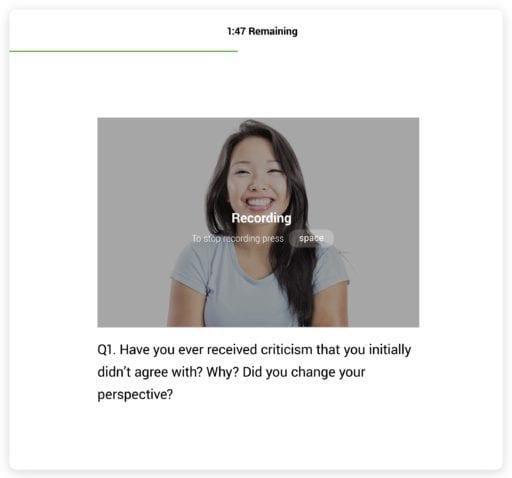
Read more: Redesigning Admissions in an Era of Grade Inflation
Using timed video assessments with Kira, you can design a space for applicants to share their story. Without the constrictions of a test score or transcript, you can ask questions about challenges they’ve overcome, their motivations for attending your school, and to share the experiences they will bring to your classroom.
With so many competing “to do” list items, emails to answer, and everything in between, it’s hard to find time to explore all of the lesser-known features of a product you use. So, we asked our team: What are your favorite hidden features you wish more Kira clients were using?
We heard about these eight tips, tricks, or small features within the Kira platform.
If you’re a partner school who has received an Inspire report from the Kira team in the past year, you’ve likely already heard about these features.
Export to CSV
If your current CRM or ATS is not integrated with Kira, you can still download Kira data through a CSV export. Every piece of information applicants or reviewers give Kira is available as a CSV that you can export to use with any other systems.
Both CSV options can be found on an Assessment's page in Kira under “Export to CSV” in the top left corner. From here, you can choose to download your “Applicant Details” or “Reviewer Details.”
Integrations are also available for most leading CRMs or homegrown systems. So contact us if you’d like to explore an integration.
Student ID and Document Upload
Did you know you can ask students to add supplemental documents and their student ID as part of their Kira registration?
This means admissions teams can review an applicant in one spot, speeding up review time significantly by bringing all materials together to be evaluated with consistent criteria and rubrics.
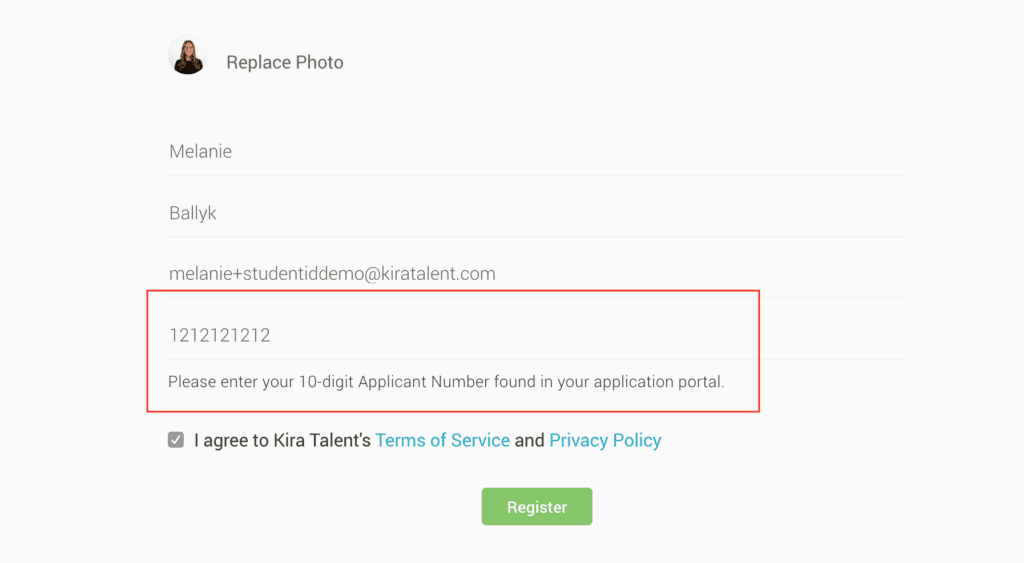
Client Resource Hub
Our Client Resource Hub is relatively new, so if you haven’t checked it out yet: It’s a handbook for all things Kira! The hub includes answers to commonly asked questions and how-to guides for tasks in the Kira platform.
Not finding what you need? Send an email to success@kiratalent.com, and we’ll help you from there.
Assign Applicants
Better manage your workflow by assigning applicants to admissions committee members. You can perform bulk assignments or assign individual reviewers to specific applicants. With bulk assignments, reviewers are randomly assigned to applicants to create an unbiased and fair way to divvy up applicants among the team.
Create a Cohort
Create a Cohort is perhaps one of the most powerful and underutilized Kira features. This is a dashboard where you can rank your applicants by their score, change the weightings of the competencies, or choose your ideal cohort size to visually assemble your future class.

Reviewer Analytics
Through our Analytics tab, you can access a view called Ratings by Reviewers. Here you can see a breakdown of how your admissions committee is rating applicants in comparison to one another. This tool can help you identify reviewers who may be evaluating applicants too harshly or too easily.
Question Sequences
Want more insight into a specific competency or subject matter? By sequencing your questions in Kira, you can build out multipart questions to get a deeper story on your applicants’ goals or past experiences.
Admissions teams can ask connected questions related to a single trait, like leadership, or probe deeper into existing content with follow-up questions. Both of the responses are then evaluated on the same rubric.
Close and Duplicate Assessments
Want to close a completed Kira assessment without emailing your Client Success team? You can watch this quick walkthrough on how to close an assessment. After an assessment is closed, you can always duplicate it and rename it for next year’s application cycle.
And if you're interested in using any of these aspects of our product, please email success@kiratalent.com, and our Client Success team can help.
There is more and more content online than ever before. But, for many of us, there is still nothing that beats a great book.
Whether you prefer an eBook or the hard copy if you’re looking to really hone in a topic for 2019, here are the books we recommend adding to your admissions bookshelf for the new year!
Gifting for a colleague, friend, or partner in higher education? We hope this list of recommendations can help you out as well!
 Race on Campus: Debunking Myths with Data
Race on Campus: Debunking Myths with Data
by Julie J. Park
With diversity, race, and affirmative action certainly being key themes in the U.S. this past year, pick up a copy of Julie J. Park’s new book to get a rigorous, empirical look at the reality of race on campus.
“Park cuts through the many false narratives around affirmative action, presenting accessible, evidence-based arguments for why race still matters in higher education. A must-read for anyone interested in better understanding how race does, and more importantly does not, play out before and after students arrive to selective college campuses.”
— Lorelle Espinosa, assistant vice president, American Council on Education
 Demographics and the Demand for Higher Education
Demographics and the Demand for Higher Education
by Nathan D. Grawe
From 2021 to 2026, the number of traditionally college-aged students will drop almost 15 percent. Yet, the demand for “elite colleges” is expected to only continue to grow. Described as “a practical guide for navigating coming enrollment challenges,” Demographics and the Demand for Higher Education analyzes demographic variables to provide forecasts for two-year colleges, elite institutions, and everything in between.
"Numbers and statistics aren’t always what they seem. Nathan Grawe provides a readable and insightful look at the sweeping demographic change occurring in America and what it means for different types of colleges. Demographics and the Demand for Higher Education is an important read for college leaders and policy makers alike." — Jon McGee, author of Breakpoint: The Changing Marketplace for Higher Education
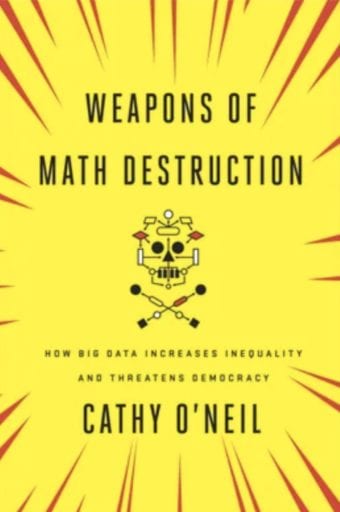 Weapons of Math Destruction: How Big Data Increases Inequality and Threatens Democracy
Weapons of Math Destruction: How Big Data Increases Inequality and Threatens Democracy
by Cathy O’Neill
Machine Learning. AI. Data-driven everything. New intelligent technologies present a compelling resource to make faster and better decisions, but as Cathy O’Neill writes, they also threaten to introduce new biases and inequalities in our processes. This book is highly relevant to folks across education who will be deciding upon or developing new technologies and systems, in fact, O’Neill just spoke to North American graduate deans at the 2018 Council of Graduate Schools Annual Meeting in December.
“O’Neil is an ideal person to write this book. She is an academic mathematician turned Wall Street quant turned data scientist who has been involved in Occupy Wall Street and recently started an algorithmic auditing company. She is one of the strongest voices speaking out for limiting the ways we allow algorithms to influence our lives… While Weapons of Math Destruction is full of hard truths and grim statistics, it is also accessible and even entertaining. O’Neil’s writing is direct and easy to read—I devoured it in an afternoon.” — Scientific American
by Ajay Agrawal, Joshua Gans and Avi Goldfarb
In conjunction with our above recommendation, Weapons of Math Destruction, Prediction Machines is not about higher education at all. Instead, it provides an actionable and approachable guide to how artificial intelligence works. Inside Higher Ed recommends Prediction Machines as a place to start a “campuswide AI discussion,” so it seemed perfect for this list.
"Prediction Machines achieves a feat as welcome as it is unique: a crisp, readable survey of where artificial intelligence is taking us separates hype from reality, while delivering a steady stream of fresh insights. It speaks in a language that top executives and policy makers will understand. Every leader needs to read this book." – Dominic Barton, Global Managing Partner, McKinsey & Company
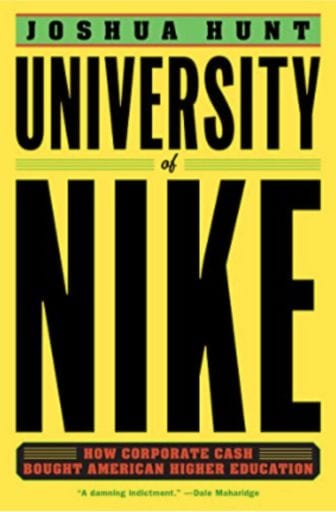 University of Nike: How Corporate Cash Bought American Higher Education
University of Nike: How Corporate Cash Bought American Higher Education
by Joshua Hunt
Joshua Hunt’s book dives into the University of Oregon, which has collected more than half a billion dollars in donations from Nike founder Phil Knight, and how donor cash has influenced and shaped the decisions, actions, and, arguably the mission, of the public institution.
“In this fascinating, candid tale, Hunt exposes Nike’s astonishing transformation of the University of Oregon into a modern American university — in other words, a power center of education, wealth, and college football unlike other institutions of learning across the globe.” — Vanessa Grigoriadis, author of Blurred Lines: Rethinking Sex, Power, and Consent
by Jerry Z. Muller
Jerry Muller showcases the dangers of focusing on metrics and quantifying performance rather than actually evaluating the content students learn in a meaningful way. The book focuses on four areas (education, medicine, business, and government), to provide a relevant wake-up call about relying too heavily on metrics like selectivity or averages on standardized test scores.
"In this clear and compelling book, Jerry Muller shows how our attempts to improve organizational outcomes through quantitative measures have metastasized into a culture of gaming and manipulation. Through carefully researched case studies on education, healthcare, and compensation, The Tyranny of Metrics makes a convincing case that we need to restore judgment and ethical considerations at a time when shallow quantification threatens the integrity of our most important institutions." — Rakesh Khurana, Harvard Business School
by Greg Lukianoff and Jonathan Haidt
Following the success of their 2015 The Atlantic cover story of the same title, The Coddling of the American Mind expands on Lukianoff and Haidt’s exploration of the
Analyzing a culmination of trends in today’s media environment, parenting, childhood education, and social media that has made campuses increasingly volatile places and that threaten to damage scholarship and the quality of American universities.
“A disturbing and comprehensive analysis of recent campus trends… Lukianoff and Haidt notice something unprecedented and frightening… The consequences of a generation unable or disinclined to engage with ideas that make them uncomfortable are dire for society, and open the door – accessible from both the left and the right – to various forms of authoritarianism.”
— Thomas Chatterton Williams, The New York Times Book Review
This week, our Founder and CEO, Emilie Cushman, was selected among the 2019 Forbes 30 Under 30 for Education.
The Kira team could not be more excited and proud of our fearless leader!
Kira was designed to help students put their best foot forward in college and university admissions, making this year’s 30 Under 30 especially relevant as listmakers are celebrated for bringing access and opportunity to the classroom and beyond.
Cushman and her co-founders started the company on a mission to change the traditional higher education admissions process, which doesn’t allow applicants to tell their story, into an experience more meaningful for both applicants and the schools they’ve applied.
Today, six years later, Kira works with more than 300 programs around the world to help admissions teams build holistic assessments to evaluate their applicants on more than grades and test scores.
“Kira is just getting started with how we are changing the face of education and there is so much more to come,” said Cushman. “While I am thrilled to be recognized, Kira Talent would not be what it is today without our amazing team and of course the four years of working with my Co-Founder, Konrad, to build this.”
The Forbes 30 Under 30 list features 600 young innovators and entrepreneurs across twenty industries. More than 15,000 nominees were collected via online submissions for 600 slots, making it a four percent acceptance rate.
From admissions forums and Reddit posts to university websites and information packets, there is an overwhelming amount of content for applicants and their families to consume throughout the admissions process.
This fall, Bentley University embarked on a quest to get into the untapped earbuds of parents, guidance counsellors, and audiophilic college applicants through a new podcast.
Admissions 101 launched in October and presents a new medium for the university to engage and educate prospective students and their families.
To talk about the new show, Suzanne Cuccurullo, Dean of Undergraduate Admission and one of the two co-hosts, joined me on the phone from Johannesburg, South Africa while on a recruiting trip.
The podcast had only been out for two weeks and while she was there, four guidance counsellors she’d spoken with had said they were already listening to the podcast and passing it on to their students as a resource.
Although the podcast leverages knowledge and real-life examples from Bentley, Admissions 101 is designed to be a resource for students applying to any U.S. college.
“We wanted to make sure no matter where you are going you would have insight into what admissions officers are looking for and what it’s like to go through this process,” said Cuccurullo.
The show tackles frequently asked questions and grey areas in the admissions process like how to tackle application essays and admissions interviews or how to make the most out of campus visits or college fairs.
“Whatever the topic, we discuss real practical tips,” she added.
Her and her co-host Mario Silva-Rosa, Director of Undergraduate Admission, plan their episodes based on a combination of a) which questions are most common among applicants and b) where students are in the application cycle.
Between the two of them, they have decades of experience and have had tens of thousands of conversations with applicants, so the challenge isn’t coming up with what to talk about; instead, it’s deciding how to narrow the list down.
When Cuccurullo and I spoke in October, undergraduate applicants around the U.S. were deciding whether or not to apply to early decision, so that was the topic of the week.
Each episode highlights some ‘do’s and ‘don’t’s, as well as a student segment where a student who recently went through the admissions process shares their perspective and first-hand experience.
For students looking for extra help applying to college, there’s a growing market of paid admissions consultants. These services can cost anywhere from a few hundred dollars to tens of thousands in exchange for illustrious promises that they will get you into your dream school.
Cuccurullo hopes that Bentley’s podcast will be able to serve students more broadly as a free resource that anyone can access.
The two co-hosts provide authentic stories and genuinely helpful tips in each episode that previously may have only been known by students with extra help from parents or consultants. For example, in the episode about admissions interviews they recommend that applicants put their mobile phone on silent during the interview and follow-up with a ‘thank you’ note.
So far, Bentley has had positive feedback on their first few episodes.
While listener data will provide quantitative metrics on the podcast’s performance, there aren’t many benchmarks to compare their efforts against. The admissions team is especially interested in hearing the word-of-mouth feedback on how counsellors, parents, and prospective students are using and sharing the content.
Admissions 101 is a new ‘experiment’ for the university and it’s also a fun new project for Cuccurullo, who has worked in Bentley’s admissions office for nearly ten years. You can hear the passion she and Silva-Rosa share for their work in each episode.
“It’s a little nerve-wracking at first, but I’m really enjoying it,” said Cuccurullo.
Want to check out Admissions 101? You can listen right here!
Considering starting an admissions podcast?
Podcasting has become extremely accessible. The actual production of the content will likely be easier than getting your marketing or communications department to approve it!
Without much more than an external microphone and some easy-to-use audio-editing software, you can record your own podcast. Our friends over at Shopify have created an amazing how-to guide to starting a podcast with limited resources or budget.
Read: How to Start a Successful Podcast (For Under $100)
I was working in the admissions office late one night
When my eyes beheld an eerie sight
For my applicant from his file began to rise
And suddenly to my surprise
He did the mash
He did the monster mash*
In our fourth annual edition of Nightmare in the Admissions Office, we had fun highlighting some of the weirdest and wildest applicant horror stories from our readers around the world wide web.
Three years, and hundreds of thousands of applications, have passed since we started this series in 2015 and among those application files, there were bound to be a few new tricks.
In fact, there were at least sixteen.
As always, these posts are meant in jest. We mean no harm to the applicants featured – please comment with your best stories for next year's post!
The 16 Applicants at Your Door This Halloween
The Scientist

“One applicant typed 'We provide many kinds of specimens to the world for 15 years, hope you are interested and could contact with me.' No additional explanation was given. Specimens...what kind of specimens? I was confused and a little disturbed.”
– Anonymous Submission
The Legal Expert

“One applicant who got stuck on the signature part of the application and wasn't sure what to do next emailed us "There are two fields: 'Signature' and 'Date', and I do not know what to insert. Could you please clarify what is required in these 2 fields, and how they are related?" My response was "This is the section where you would type your name and today's date which would constitute your signature...". What I really wanted to type was "don't bother, you're probably not getting in."
– Anonymous Submission
The Secret Agent

“An admitted international student went MIA for 10 weeks leading up to the start of classes and randomly showed up late for orientation after having their application withdrawn due to lack of response. I had to tell him that he had to go home, because he failed to arrive to orientation, which is mandatory for all students. He received dozens of emails telling him his application was in danger of being withdrawn and that it finally was withdrawn, but he never checked his email. He just showed up!”
– Meredith R. - Case Western Reserve University
The Arts-and-Crafters

“The amount of students who glue rice to their applications to Rice University is too damn high.”
The Lover

“Graduate school admissions. Our application requires 4 separate essays. This student wrote all four as a long, drawn out love letter to one of our faculty members. The faculty member wasn't taking new students into the lab and had never met or talked to the prospective student. The student had taken all the info for her love letters from his website in addition to providing a list of his publications (also from his website) that she had read. I walked away from reading her application with zero sense of who she was but having learned a lot more about the faculty member!”
The Author

“We had an applicant send in a book they wrote and published themselves. It was difficult for us to really read it, because for some reason the book really stank. We just put it in their file and shut the door.”
The Examiner

“A student wrote down that they can 'Distinguish bra cup sizes by a simple glance at a woman.'"
The Turtle

“I once had an applicant come through who put that their preferred name was “The Turtle”. On their college application.”
The Cat in the Hat

“An applicant submitted an essay composed of Japanese characters that when put through google translate turned out to be a loosely translated version of cat in the hat.”
The Shopper
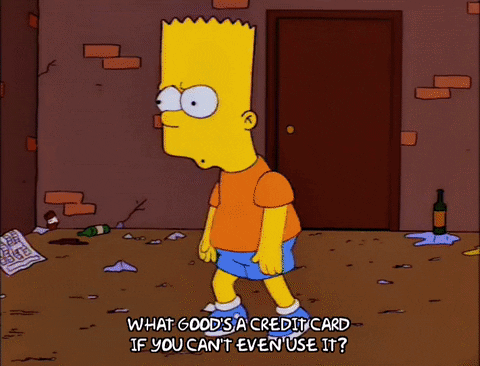
“Question: Do you currently hold a US Visa? No, Mastercard.”
The Mathematician

“Math Ph.D. applicant's essay literally said "I LIKE MATH" in red crayon. I think he figured his 4.0 GPA and awesome GRE quant score was all he needed. He didn't get in.”
The Chicken

“International applicant sent in a photo of them conducting a military band in a chicken suit. I have no clue why. It went up on the Wall of WTF in our office.”
The... "Actually, Let's Leave This One Untitled"

“It's been almost a decade since I worked in admissions but I still remember the student who used the email address hotnwildorgasm@? on both their admissions and scholarship applications.”
The Scatologist

“A student wrote a personal statement about the time they analyzed their own feces for science. It started with, "Once, in the name of science, I studied a culture of my own feces." I was hooked. I don't remember the rest of the essay, but I do remember that it was genuinely very well-written, interesting, and a good response to the question. I gave them a very high application score.”
– No_ThisisAdmissions on Reddit
The Bed Bug

“A bed bug was the most startling part of an admissions application I received. I now know that will quarantine an entire building and that there are bed bug sniffing dogs.”
The Tuna Fish Sandwich

“A good one from this past year was this kid who wrote his essay about becoming a tuna fish sandwich. It started with him waking up in bed to discover he was a tuna fish sandwich, thus making him unable to move. He talked about how his mom walked into the room, freaked out because she couldn't find him, and instead found a tuna fish sandwich and proceeded to eat it. In detail he described the sensation of being chewed up and digested by his mother. I kept waiting for some profound revelation at the end, or a moral of the story, but nope. That was it. Such a bizarre essay.”
Happy Halloween!
* Lyrical credit: Bobby Picket for the "Monster Mash"
A headline ran on September 20, 2018, in Quartz asking, “Is grade inflation just another way for privileged kids to get ahead?”
The question grew out of a new study from the Thomas B. Fordham Institute showing that grade inflation occurs more commonly in wealthier schools than poorer ones in the United States.
North of the border, another story revealed University of Waterloo’s engineering program, one of the most prestigious in Canada, keeps a secret list to adjust high school marks for schools known to pump up their students’ grades for the admissions process.
More than 50 percent of American teenagers finish with above an A average in high school, and, although I couldn’t find a Canadian statistic to compare, I would not be surprised if Canadian high schools are producing similar scoring grads.
For example, in 2018 the minimum entrance grades at Canadian engineering programs like Queen’s, University of Toronto, and McGill all hover around 90 percent.
With the rise of common admissions applications, like the CommonApp or OUAC, students are also able to apply to more schools more easily. Today, a student who previously might have only applied to their top three schools now can apply to ten or twelve in less time.
Making college and university applications easier is better for students on the front-end. However, it’s leading many undergraduate programs to have more applicant files to review, making it more difficult for students to receive an admissions offer.
Even if the number of genuinely interested students hasn’t actually risen, in some cases students who truly want to go to your school are competing with students who simply ticked more boxes to apply at more schools using the same content.
The increased competition in admissions has a particularly negative effect on students who have not had the same opportunities to get involved outside of the classroom, or who have struggled academically.
And so begins the cycle:
More high scoring students apply for the same number of spots, driving cutoffs higher to narrow the pool.
As cutoffs get higher, teachers and students are under immense pressure to graduate students who can meet those cutoffs.
Holistic Admissions Through Supplementary Application Components in Undergraduate Programs
Holistic admissions processes were once limited to elite schools and competitive graduate programs. However, we now see more schools introducing supplementary admissions packages that include additional requirements like essays, personal statements, video assessments, and interviews.
With the increasing competition for spots at the undergraduate level, holistic review is becoming a welcome addition to the admissions process at many schools.
Take, for example, McMaster’s Faculty of Engineering.
Thousands of high scoring students compete for 900 spots in the program. Adding a brief timed video assessment gave McMaster the chance to actually hear from their applicants, evaluating their passion for engineering and communication skills on a level playing field.
READ: "How McMaster Engineering Uses Kira To Identify Well-Rounded Applicants"
At the University of Michigan Ross School of Business, their undergraduate program has introduced a personal reflection and an “artifact” to their admissions process. These materials are designed to evaluate applicants’ ability to articulate their “deep interest” in business beyond their in-class performance.
READ: "Here Are Our Favorite Portfolio Artifacts Ross Applicants Have Submitted Recently" on Michigan Ross’s Undergraduate Admissions Blog
At DePaul University, they introduced four essay questions at the undergraduate level that required short answers. These responses were evaluated against eight non-cognitive variables associated with success in college that have been established by Dr. William Sedlacek’s extensive admissions research. Over the years that followed, DePaul published the results of the change in “Linking Admission Strategies to Student Retention.”
READ: "Demystifying Holistic Admissions: The Comprehensive Guide to Holistic Review"
To learn more about holistic admissions, including case studies and how-to articles, check out more articles on this topic.

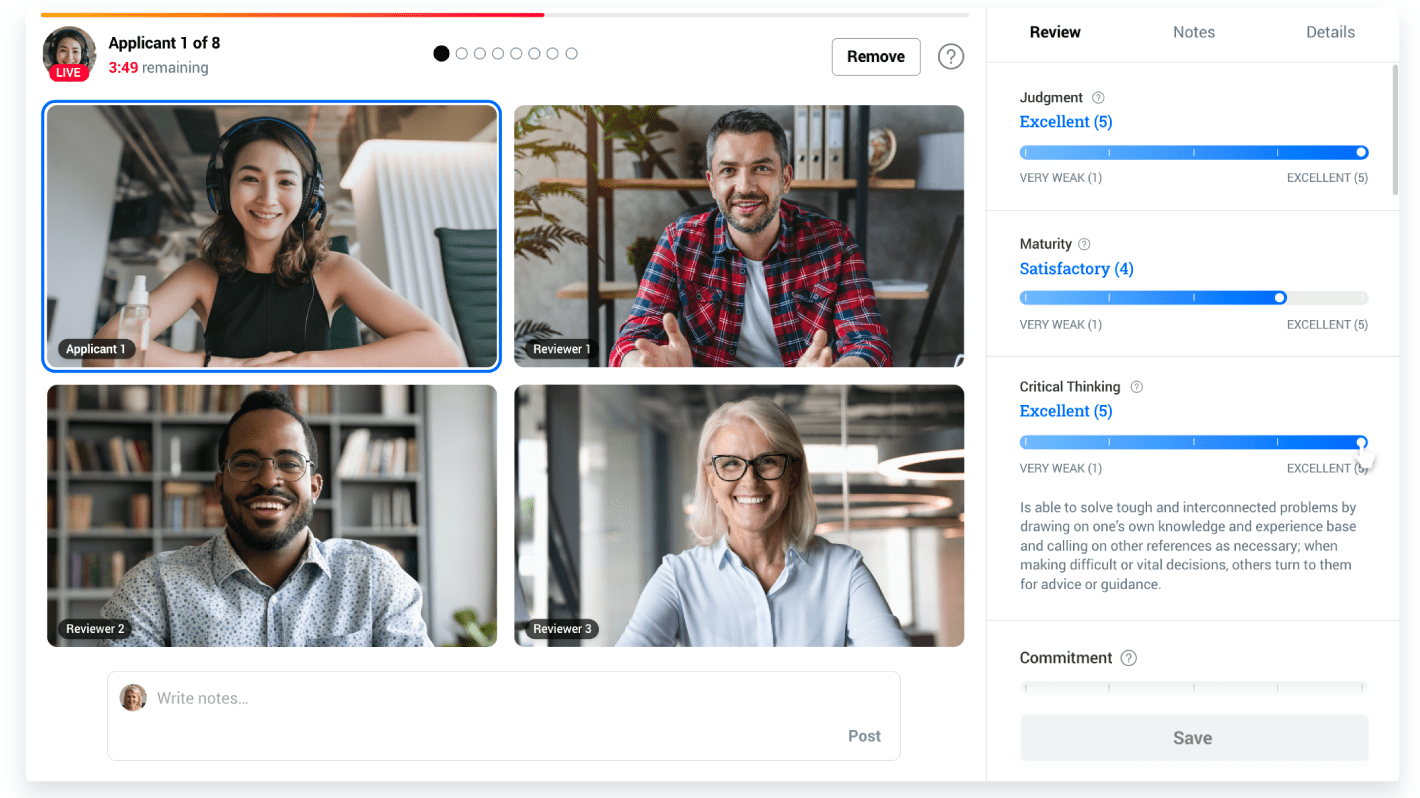

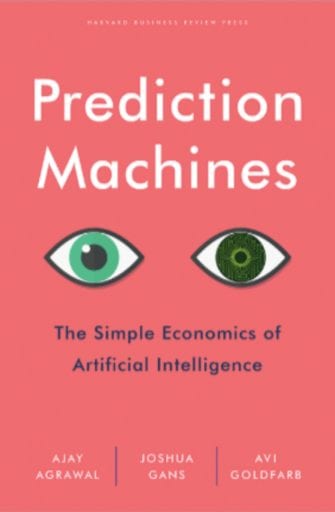 Prediction Machines
Prediction Machines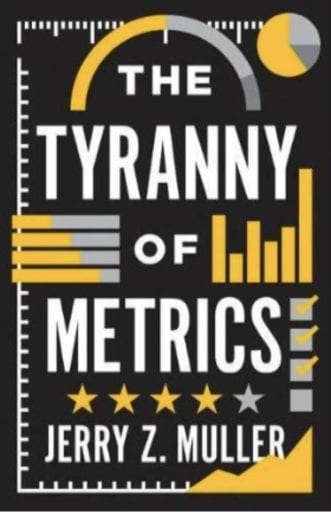 The Tyranny of Metrics
The Tyranny of Metrics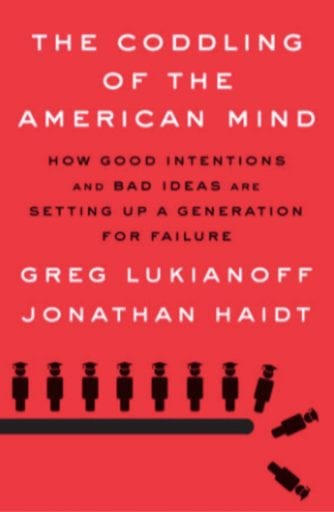 The Coddling of the American Mind: How Good Intentions and Bad Ideas Are Setting Up a Generation for Failure
The Coddling of the American Mind: How Good Intentions and Bad Ideas Are Setting Up a Generation for Failure